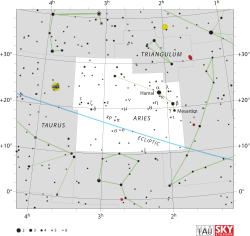51 Arietis
51 Arietis, som är stjärnans Flamsteed-beteckning, är en ensam stjärna belägen i den mellersta delen av stjärnbilden Väduren. Den har en skenbar magnitud på ca 6,62[2] och kräver åtminstone en handkikare för att kunna observeras. Baserat på parallax enligt Gaia Data Release 2 på ca 47,2[1] mas, beräknas den befinna sig på ett avstånd på ca 69 ljusår (ca 21 parsek)[10] från solen. Den rör sig bort från solen med en heliocentrisk radialhastighet av ca 10 km/s[6] och ingår i rörelsegruppen IC 2391.[11]
| 51 Arietis | |
 | |
| Observationsdata Epok: J2000.0 | |
|---|---|
| Stjärnbild | Väduren |
| Rektascension | 03t 02m 26,02628s[1] |
| Deklination | +26° 36′ 33,2602″[1] |
| Skenbar magnitud () | 6,623 ± 0,005 (V)[2], 6,624 ± 0,010(V)[3] |
| Stjärntyp | |
| Spektraltyp | G8 V[4] |
| B–V | 0,696 ± 0,009[5] |
| Astrometri | |
| Radialhastighet () | 9,5 ± 0,1[6] km/s |
| Egenrörelse (µ) | RA: 233,122 ± 0,120[1] mas/år Dek.: -168,438 ± 0,124[1] mas/år |
| Parallax () | 47,1551 ± 0,0603[1] |
| Avstånd | 69,17 ± 0,09 lå (21,21 ± 0,03 pc) |
| Absolut magnitud () | 4,85 ± 0,07[2] |
| Detaljer | |
| Massa | 1,04[2] M☉ |
| Radie | 0,99[2] R☉ |
| Luminositet | 0,92[7] L☉ |
| Temperatur | 5 666[7] K |
| Metallicitet | 0,15 (Fe/H)[7] dex |
| Vinkelhastighet | 4,08[8] km/s |
| Ålder | 1,40[6] miljarder år |
| Andra beteckningar | |
| LTT 10989, GJ 120.2, PLX 628.01, WEB 2781, HD 18803, PPM 92163, WISEA J030226.22+263631.4, AG+26 307, HIC 14150, SAO 75696, YZ 26 1553, ASCC 655572, HIP 14150, SKY# 4558, Gaia DR2 115311458058061440, BD+26 503, IRAS 02594+2624, SPOCS 148, Gaia DR1 115311453761724544, GC 3640, LSPM J0302+2636, TYC 1790-948-1, GCRV 1685, 2MASS J03022598+2636334, USNO-B1.0 1166-00036324, GEN# +1.00018803, NLTT 9664, uvby98 100018803[3][9] | |
Egenskaper
redigera51 Arietis är en gul[4] till vit solliknande stjärna i huvudserien av spektralklass G8 V.[4] Den har en massa som är ungefär lika med en[2] solmassa, en radie som är ungefär lika med en[2] solradie och utsänder ca 0,92[7] gånger den energi som solen avger från dess fotosfär vid en effektiv temperatur av ca 5 700 K.[7]
Referenser
redigera- Den här artikeln är helt eller delvis baserad på material från engelskspråkiga Wikipedia, 51 Arietis, 17 december 2020.
Noter
redigera- ^ [a b c d e f] Brown, A. G. A.; et al. (Gaia collaboration) (August 2018). "Gaia Data Release 2: Summary of the contents and survey properties". Astronomy & Astrophysics. 616. A1. arXiv:1804.09365. Bibcode:2018A&A...616A...1G. doi:10.1051/0004-6361/201833051. Gaia DR2 record for this source at VizieR.
- ^ [a b c d e f g] Fuhrmann, Klaus (February 2008), "Nearby stars of the Galactic disc and halo - IV", Monthly Notices of the Royal Astronomical Society, 384 (1): 173–224, 176, Bibcode:2008MNRAS.384..173F, doi:10.1111/j.1365-2966.2007.12671.x.
- ^ [a b] ”Basic data: V* 51 Ari – Spectroscopic binary” (på engelska). Centre de Données astronomiques de Strasbourg. http://simbad.u-strasbg.fr/simbad/sim-basic?Ident=51+Ari&submit=SIMBAD+search. Läst 18 maj 2019.
- ^ [a b c] Montes, D.; et al. (November 2001), "Late-type members of young stellar kinematic groups - I. Single stars", Monthly Notices of the Royal Astronomical Society, 328 (1): 45–63, arXiv:astro-ph/0106537, Bibcode:2001MNRAS.328...45M, doi:10.1046/j.1365-8711.2001.04781.x.
- ^ van Leeuwen (2007). ”Hipparcos, the New Reduction” (på engelska). http://vizier.u-strasbg.fr/viz-bin/VizieR-5?-out.add=.&-source=I/311/hip2&HIP=14150. Läst 18 maj 2019.
- ^ [a b c] Casagrande, L.; et al. (June 2011), "New constraints on the chemical evolution of the solar neighbourhood and Galactic disc(s). Improved astrophysical parameters for the Geneva-Copenhagen Survey", Astronomy and Astrophysics, 530: A138, arXiv:1103.4651, Bibcode:2011A&A...530A.138C, doi:10.1051/0004-6361/201016276.
- ^ [a b c d e] Takeda, Yoichi (April 2007), "Fundamental Parameters and Elemental Abundances of 160 F-G-K Stars Based on OAO Spectrum Database", Publications of the Astronomical Society of Japan, 59 (2): 335–356, Bibcode:2007PASJ...59..335T, doi:10.1093/pasj/59.2.335.
- ^ Martínez-Arnáiz, R.; et al. (September 2010), "Chromospheric activity and rotation of FGK stars in the solar vicinity. An estimation of the radial velocity jitter" (PDF), Astronomy and Astrophysics, 520: A79, arXiv:1002.4391, Bibcode:2010A&A...520A..79M, doi:10.1051/0004-6361/200913725.
- ^ "LTT 10989 -- High proper-motion Star", SIMBAD Astronomical Database, Centre de Données astronomiques de Strasbourg, hämtad 2012-08-16.
- ^ van Leeuwen, F. (November 2007), "Validation of the new Hipparcos reduction", Astronomy and Astrophysics, 474 (2): 653–664, arXiv:0708.1752, Bibcode:2007A&A...474..653V, doi:10.1051/0004-6361:20078357.
- ^ "The Colour of Stars", Australia Telescope, Outreach and Education, Commonwealth Scientific and Industrial Research Organisation, December 21, 2004, archived from the original on March 10, 2012, hämtad 2012-01-16



